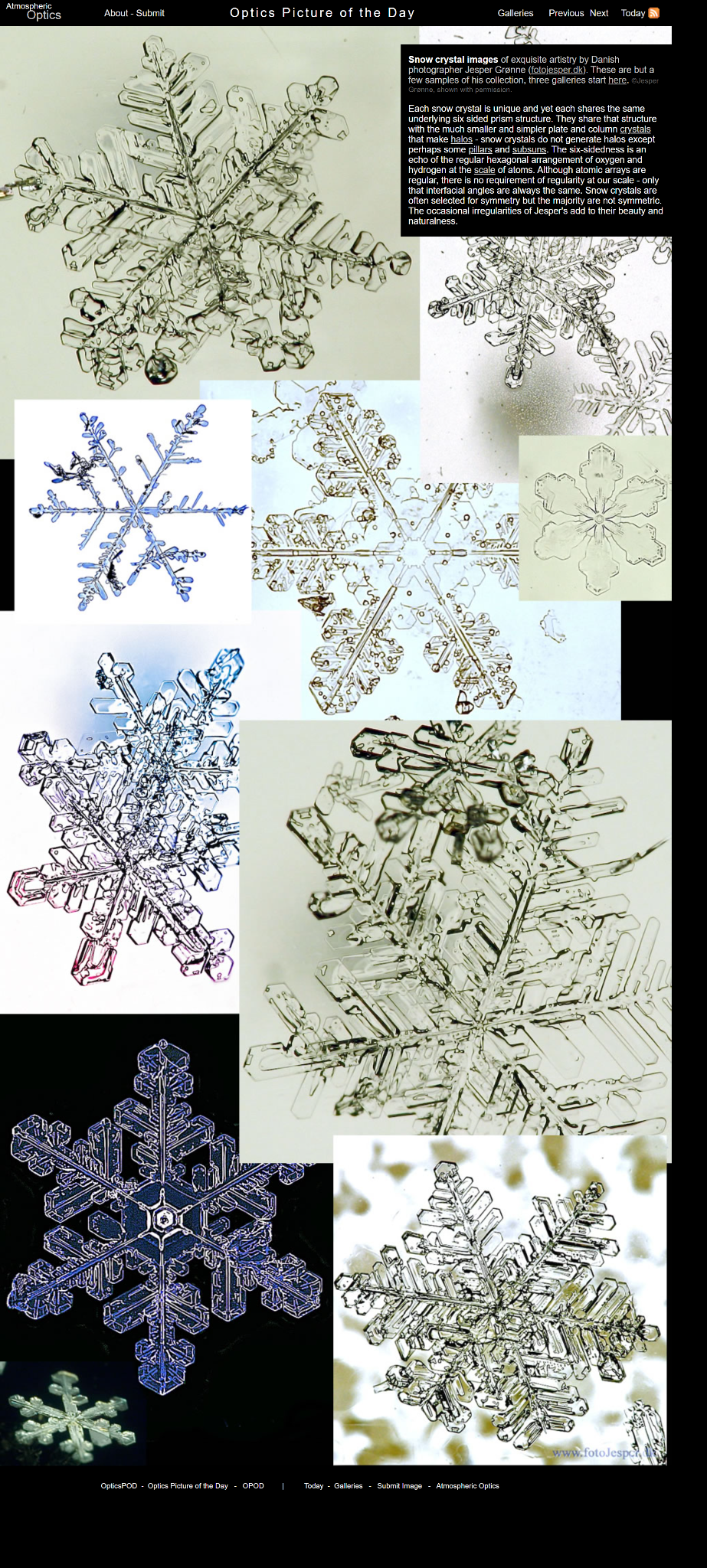Snowflakes!
Snowflakes: Nature's Unique Masterpieces
Snowflakes are truly a wonder of nature. Each delicate snow crystal is a work of art, intricately designed by the forces of physics and chemistry. Danish photographer Jesper Grønne has captured the exquisite beauty of these snow crystals in his collection, showcasing their mesmerizing patterns and intricate structures.
At first glance, it may seem that every snowflake is different from one another. However, upon closer inspection, we discover that they all share a common underlying structure - a six-sided prism. This hexagonal symmetry is a reflection of the regular arrangement of oxygen and hydrogen atoms at the atomic scale. While snow crystals can vary in shape and size, their interfacial angles remain consistent.
While many snow crystals are selected for their symmetry, the majority are not perfectly symmetrical. In fact, the occasional irregularities in Jesper's collection only enhance their natural beauty. These imperfections give each snowflake its unique character, adding to the wonder and fascination they inspire.
The Science Behind Snowflakes
The formation of snowflakes begins high up in the atmosphere, where water vapor condenses onto tiny ice nuclei. As the water vapor freezes, it forms hexagonal ice crystals. These crystals then grow as more water vapor freezes onto their surfaces, creating intricate branches and delicate patterns.
The growth of a snowflake is influenced by temperature and humidity conditions in the atmosphere. As the snowflake falls through different layers of the atmosphere, it encounters varying conditions, resulting in the formation of different crystal shapes. Factors such as temperature, humidity, and wind patterns all play a role in shaping the final structure of a snowflake.
The Diversity of Snowflakes
Contrary to popular belief, not all snowflakes are perfectly symmetrical and hexagonal. Snowflakes can take on a wide variety of shapes and structures, depending on the conditions they encounter during their formation. Some common types of snowflakes include:
-
Stellar Dendrites: These are the classic, six-branched snowflakes that most people envision when they think of a snowflake. They have intricate branching patterns and are often symmetrical.
-
Column Crystals: These snowflakes form when the temperature is slightly below freezing. They have a columnar structure and can be either hollow or solid.
-
Plate Crystals: Plate crystals are thin, flat, and often have hexagonal or dendritic shapes. They are more common in warmer conditions.
-
Needles: Needle-shaped snowflakes are long and slender, resembling tiny ice rods. They form in colder temperatures and low humidity.
The Beauty of Snowflakes
Snowflakes have captivated our imagination for centuries, and it's easy to see why. Their intricate designs and delicate structures are a testament to the awe-inspiring beauty of nature. When light interacts with these tiny ice crystals, it scatters and refracts, creating a mesmerizing display of colors and optical phenomena.
One such phenomenon is the creation of halos around the Sun or Moon. While snow crystals themselves do not generate halos, certain types of snowflakes, such as pillars and subsuns, can contribute to their formation. Halos occur when light is bent and refracted by ice crystals in the atmosphere, creating a ring of light around the celestial body.
Capturing the Magic
Photographers like Jesper Grønne have dedicated their talents to capturing the enchanting beauty of snowflakes. Through careful lighting and macro photography techniques, they are able to reveal the intricate details and unique characteristics of each snow crystal. These stunning images allow us to appreciate the artistry of nature and remind us of the delicate balance that exists in our world.
In conclusion, snowflakes are not only a symbol of winter wonderland but also a testament to the scientific marvels of our natural world. Their unique structures and diverse forms showcase the complexity and beauty that can arise from the simplest of building blocks. So, the next time you catch a snowflake on your fingertip, take a moment to marvel at its individuality and the extraordinary forces that shaped it.
Snow crystal images of exquisite artistry by Danish photographer Jesper Grønne (fotojesper.dk). These are but a few samples of his collection, three galleries start here. ©Jesper Grønne, shown with permission.
Each snow crystal is unique and yet each shares the same underlying six sided prism structure. They share that structure with the much smaller and simpler plate and column crystals that make halos - snow crystals do not generate halos except perhaps some pillars and subsuns. The six-sidedness is an echo of the regular hexagonal arrangement of oxygen and hydrogen at the scale of atoms. Although atomic arrays are regular, there is no requirement of regularity at our scale - only that interfacial angles are always the same. Snow crystals are often selected for symmetry but the majority are not symmetric. The occasional irregularities of Jesper's add to their beauty and naturalness.

Note: this article has been automatically converted from the old site and may not appear as intended. You can find the original article here.
Reference Atmospheric Optics
If you use any of the definitions, information, or data presented on Atmospheric Optics, please copy the link or reference below to properly credit us as the reference source. Thank you!
-
<a href="https://atoptics.co.uk/blog/snowflakes/">Snowflakes!</a>
-
"Snowflakes!". Atmospheric Optics. Accessed on November 26, 2024. https://atoptics.co.uk/blog/snowflakes/.
-
"Snowflakes!". Atmospheric Optics, https://atoptics.co.uk/blog/snowflakes/. Accessed 26 November, 2024
-
Snowflakes!. Atmospheric Optics. Retrieved from https://atoptics.co.uk/blog/snowflakes/.